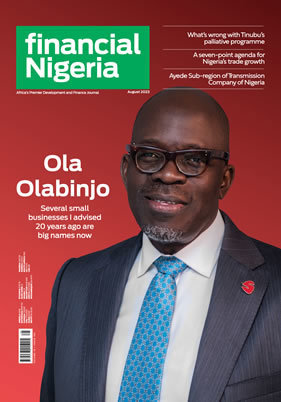
Martins Hile, Editor, Financial Nigeria magazine
Follow Martins Hile
![]() @martinshile
@martinshile
Subjects of Interest
- Governance
- SMEs
- Social Development
Rethinking Nigeria's development for people-centred outcomes 17 Jun 2025
President Bola Tinubu administration has made infrastructure development a cornerstone of its economic strategy. In May 2024, the president appointed InfraCorp as the Lead Arranger and Developer of Evergreen City, with a $37 billion investment target by 2030. This landmark initiative, emphasising green industrialisation and public-private partnerships, underscores a strategic approach to development. The allocation of N4.06 trillion from the 2025 budget to infrastructure – 8.16% of the total budget, up from 6.63% in 2024 – is testament to this infrastructure-led development approach. Major projects like the Lagos-Calabar Coastal Highway and the Sokoto-Badagry Superhighway are being actively developed, with over N2.5 trillion already approved in 2025 for road infrastructure projects.
Yet, this approach, while producing some visible results, perpetuates a fundamental misconception of development that has plagued Nigeria for decades. Despite substantial investments in roads and public buildings across successive administrations, Nigeria's ranking on the Human Development Index (HDI) remains awfully low. Data from the 2025 Human Development Report shows Nigeria's HDI increased by approximately 24.72% in 20 years, but remains low at 0.560, placing the country near the bottom of the medium human development category. In 2022, 33% of Nigerians were multidimensionally poor, and inequality accounts for a 32.3% loss in HDI.
This infrastructure-investment paradox becomes starker when compared with peer countries. Ghana, with significantly lower infrastructure spending per capita, achieved superior HDI performance of 0.628 in 2023 compared to Nigeria's 0.560. The country's recent focus on technical and vocational education alongside infrastructure development contributed to this pay-off. Rwanda, despite starting from a much lower base after the 1994 genocide, has achieved remarkable progress by balancing infrastructure with human capital investments. Between 2000 and 2023, Rwanda's HDI improved by 67%, while Nigeria's increased by only 25%. The difference lies in prioritisation: Rwanda allocated 24% of its budget to education and health combined in 2023, compared to Nigeria's 12.07% allocation for the same sectors in 2025.
Similarly, Vietnam, another country with significant economic challenges, illustrates how strategic human capital investment accelerates development. Despite lower overall infrastructure spending than Nigeria, Vietnam's literacy rate reached 96.6% by 2023, compared to Nigeria's 59.6%, directly contributing to its superior HDI ranking of 0.766.
This disconnect, between infrastructure investment and human development outcomes, demands serious examination. For one thing, it reveals a fundamental misunderstanding: development is not just about bricks-and-mortar projects. It is a far more complex process that is beyond ribbon-cutting ceremonies for new roads and hospital buildings.
Nobel laureate Amartya Sen's influential work, "Development as Freedom," fundamentally redefines development as the expansion of human capabilities and freedoms. The Indian economist and philosopher argues that true development removes barriers like poverty, poor health, and lack of education, enabling individuals to lead lives they value. This approach shifts focus from economic indicators to human capabilities – what people can actually do, and be, with their resources.
The United Nations Development Programme amplifies this perspective in its 2025 Human Development Report, emphasising that "the choices that people have and can realise, within ever expanding freedoms, are essential to human development, whose goal is for people to live lives they value and have reason to value." This theoretical foundation challenges Nigeria's infrastructure-centric development model by highlighting that physical structures are merely tools that should enhance human capabilities rather than ends in themselves. A new road or bus terminal provides little developmental value if people lack the economic means to use them effectively or if governance failures prevent their optimal operation.
The HDI implements this broader understanding by measuring development across four key dimensions: mean years of schooling, expected years of schooling, life expectancy at birth, and gross national income per capita. This framework acknowledges that development encompasses multiple dimensions of human well-being, not just economic advancement or physical infrastructure.
Nigeria's development narrative – dominated for a long time by visible infrastructure such as roads and bridges – highlights the shortcomings of equating progress solely with infrastructure expansion. The Dangote Refinery, while helping to bridge the country's energy infrastructure gap, exemplifies this limitation. Despite its $19 billion investment and potential to save Nigeria $10 billion annually in fuel imports, it hasn't substantially enhanced citizens' technical capabilities or improved widespread access to petroleum products, reinforcing that infrastructure alone doesn't guarantee economic liberation.
This infrastructure-centric approach is deeply embedded in Nigeria's fiscal planning, as seen in the 2025 budget allocation. While N4.06 trillion has been budgeted for infrastructure projects, education and health – arguably the backbone of long-term national development – are relegated to lower priority with N3.5 trillion (7.08%) and N2.4 trillion (4.99%), respectively. This prioritisation of physical structures over human capital investments has been a long-standing trend in Nigeria's fiscal planning. The consequences are writ large, from deteriorating educational outcomes, subpar healthcare services, and shrinking opportunities for Nigerians to acquire the technical expertise essential for operating high-value industries.
Nigeria's development challenges demand a complete reorientation toward what can be termed "human-centred infrastructure development." This approach aims to evaluate infrastructure projects not merely by their physical specifications but by their capacity to enhance human capabilities and expand freedoms.
The Human Infrastructure Quotient (HIQ) framework offers a systematic methodology for this evaluation. Projects would be scored across four key metrics: Skills Transfer Potential (this means the project must provide minimum of 20% local workforce upskilling). Accessibility Threshold (this sets a target for projects to achieve 75% population coverage within reasonable distances, with specific provisions for marginalised communities). Maintenance Capacity Building (this requires one trained local technician per 10 infrastructure units with ongoing professional development). Finally, Gender Parity in Benefits (this mandates minimum 40% female participation in both construction and long-term operational roles).
Each metric would be weighted equally, with projects requiring a minimum HIQ score of 70% to qualify for public funding. This framework transforms infrastructure from mere physical assets into catalysts for human development. A road project, for instance, would need to demonstrate how it connects underserved populations to economic opportunities, includes skills training for local communities, and ensures women benefit equally from improved mobility and economic access.
Countries that have successfully transformed their development trajectories typically prioritise human capital alongside infrastructure. South Korea's development miracle involved simultaneous investments in education, healthcare, and infrastructure, with particular emphasis on building technological capabilities. Similarly, Botswana's prudent resource management combined infrastructure development with substantial education investments, achieving one of Africa's highest HDI growth rates.
To realise the full potential of the HIQ framework, several key shifts are essential, supported by specific measurement and accountability mechanisms. First and foremost, development planning should prioritise comprehensive assessments of capability deprivations, rather than being driven by political considerations. This requires establishing Community Development Audits before any major infrastructure project, conducted by independent bodies and involving citizen participation. These audits would identify specific capability gaps that infrastructure should address, with mandatory public reporting of findings.
Second, every major infrastructure project should include substantial human capital development components. The Lagos-Ibadan rail project, where the China Civil Engineering Construction Corporation trained 17,000 local technicians, offers a replicable template for this approach. Future projects should be required to establish Skills Development Partnerships with local universities and technical institutions, creating pathways for Nigerians to gain expertise in operating and maintaining advanced infrastructure.
Third, sustainability mechanisms must be built into infrastructure projects from inception. This includes training local technicians for maintenance, ensuring affordability for intended beneficiaries, and creating governance structures that prevent infrastructure decay. Annual Public Development Reviews should track infrastructure performance not just on utilisation rates, but on human development outcomes, with citizen feedback mechanisms integrated into evaluation processes.
To ensure accountability, Nigeria should establish a National Human Development Monitoring System that publishes quarterly reports on how infrastructure investments translate into improvements in education, health, and economic opportunities. Civil society organisations should be empowered with funding and legal frameworks to conduct independent assessments of development projects, creating a robust system of checks and balances.
Infrastructure becomes truly developmental when it enhances human capabilities and is supported by institutional frameworks that ensure sustainable operation. Roads matter when they connect people to economic opportunities; hospitals make a difference when staffed with qualified personnel and equipped with necessary supplies; schools transform lives when they provide quality education that develops human capabilities.
The Lagos Eko Digital Initiative exemplifies the synergistic relationship between physical infrastructure and human development. The initiative – which aims to empower over 100,000 pupils in Lagos State's primary and secondary schools with ICT, networking, and other technological skills, preparing them for the digital economy – reportedly increased STEM proficiency by 40% between 2020-2023. Designed to complement Lagos State's broader physical infrastructure development, this initiative demonstrates the positive impact of human capital development through education and skills training.
As Nigeria charts its development path under the current administration's ambitious infrastructure agenda, a people-centred approach must guide policy formulation and implementation. True progress is measured not just by the roads built or the bridges erected, but by the extent to which they enhance human capabilities and improve quality of life. By placing people at the heart of development, Nigeria can move beyond physical expansion and toward a future where its citizens have the freedom, resources, and opportunities to thrive.
Martins Hile is a sustainability strategist and editorial consultant.
Latest Blogs By Martins Hile
- Social outcomes as the tail that wags climate action
- Lessons for Nigeria's climate finance strategy
- Rethinking Nigeria's development for people-centred outcomes
- Nigeria's economic prospects in a changing world order
- Naira commoditisation as CBN's cashless policy flaw



